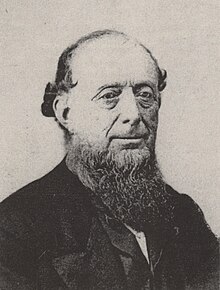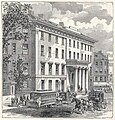Isaiah Rogers
Isaiah Rogers | |
|---|---|
 | |
| Born | August 17, 1800 |
| Died | April 13, 1869 (aged 68) |
| Occupation | Architect |
| Practice | Rogers, Whitestone & Co. |
| Buildings | |
Isaiah Rogers (August 17, 1800 – April 13, 1869) was an American architect from Massachusetts who eventually moved his practice south, where he was based in Louisville, Kentucky, and Cincinnati, Ohio. He completed numerous designs for hotels, courthouses and other major buildings in Boston, Massachusetts, and New York City, before that relocation.
He was appointed in 1863 as the
Background
Rogers was born in Marshfield, Massachusetts to Isaac Rogers, a farmer and shipwright, and his wife Hannah Ford. In 1823 he married Emily Wesley Tobey of Portland, Maine. The couple had eight children, four of whom survived infancy. Two of his sons followed him into the profession of architecture.
Rogers was a student of Solomon Willard. He became one of the country's foremost hotel architects and was renowned for Boston's Tremont House (the first hotel with indoor plumbing), the Astor House in New York City, and the Exchange Hotel in Richmond, Virginia. He designed the Burnett House in Cincinnati, then the largest and most elegant hotel in the Midwest. He also designed New York's Astor Opera House (1847).
With William Keeley, Rogers designed
His design for the fourth
Rogers was the supervising architect, the last of five, who worked on the Ohio Statehouse. He completed the building in 1861.
In 1853, Rogers founded an architecture firm in Louisville, Kentucky with another architect named Henry Whitestone. That firm was originally named Rogers, Whitestone & Co., Architects.[1] It is still practicing today under the name of Luckett & Farley Architects, Engineers, & Interior Designers.
From 1863 to 1865, due to his friendship with fellow Cincinnatian
Selected architectural works
-
Thomas Gaff House (Hillforest)
-
Merchants Exchange (Boston) (1852)
-
Merchants Exchange building, Wall Street(National City Bank Building)
-
Tremont House, Boston, Massachusetts
- 1827 Tremont Theatre (Boston), later rebuilt as Tremont Temple (1896)
- 1829 Tremont House, Boston
- 1830 Old State House, Boston, redesign (with William Washburn) in the Classical Revival style to serve as a City Hall until 1841[2][3]
- 1832–33 Commercial Wharf, Boston
- 1833 Bangor House, Bangor, Maine
- 1833 Captain Robert Bennet Forbes House, Milton, Massachusetts
- 1836 John Jacob Astor House, a hotel on the site of Astor's home in New York City that lasted 80 years. In 1913 city officials announced that "the southern half of the hotel was to be torn down to accommodate construction of the Brooklyn Rapid Transit Company subway (now the N and R lines). Two years later, 217 Broadway was built." It was first called the Astor House Building and then the Astor Building.[4]
- 1836 Merchants Exchange building, Wall Street
- 1840 Old Granary Burying Ground in Boston
- 1841 Merchants Exchange (Boston)
- 1842 New York Merchants Exchange, later the New York Customs House, New York City
- 1843 Egyptian Revival gate and fence for Touro Cemetery in Newport, Rhode Island
- 1845 Kent-Valentine House, Richmond, Virginia
- 1846 Howard Athenaeum, Boston
- 1850s Thomas Gaff House, Aurora, Indiana
- 1852 Cathedral of the Assumption in Louisville, Kentucky was designed by William Keeley and Rogers
- 1859 Oliver House, Toledo, Ohio
- Nashville, Tennessee (destroyed by fire, Christmas 1961)
See also
References
- Notes
- ^ "Courier-Journal Classified Ad 8". August 24, 1855. Archived from the original on April 2, 2015.
- ^ "Historic Boston Buildings". Archived from the original on August 1, 2018. Retrieved January 30, 2010.
- ^ bostonhistory.org
- ^ David W. Dunlap "Commercial Property; Former Astor Office Building Looks Back, and Up", New York Times, July 7, 1999
- Additional sources
External links
- Merchants' Exchange, New York Architecture Images






